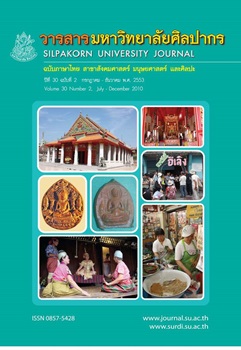การศึกษาเปรียบเทียบคำศัพท์ภาษาไทถิ่นในจังหวัดสกลนคร A comparative Lexical Study of Tai Dialects in Sakon Nakhon Province
Main Article Content
Abstract
บทคัดย่อ
บทความนี้มีวัตถุประสงค์เพื่อศึกษาเปรียบเทียบคำศัพท์ภาษาไทถิ่นในจังหวัดสกลนคร จำนวน 5 ภาษา ได้แก่ภาษาญ้อ ภาษาผู้ไท ภาษาโย้ย ภาษาลาวหรือภาษาอีสาน และภาษากะเลิง โดยมีสมมติฐานว่า คำศัพท์ภาษาญ้อภาษาลาว และภาษาโย้ย มีความสัมพันธ์กันมากกว่าภาษากะเลิงและภาษาผู้ไทการวิจัยครั้งนี้ผู้วิจัย ได้สร้า้งรายการคำซึ่งประกอบด้วยหน่วยอรรถจำนวน 800 หน่วยอรรถ แบ่งเป็น 18 หมวดแล้วนำหน่วยอรรถทั้งหมดไปสัมภาษณ์ผู้บอกภาษาทงั้ 5 ภาษา ภาษาละ 4 คน ที่ไี่ด้คัดเลือกไว้โดยควบคมุ ตัวแปรทางสังคม คือ อายุ เพศ การศึกษา อาชีพ และภูมิลำเนา เมื่อได้ข้อมูลแล้วผู้วิจัยจึงได้คัดเลือกหน่วยอรรถที่มีความหมายชัดเจน ผู้บอกภาษาทุกคนรู้จักดี ตัดหน่วยอรรถที่มีความหมายคลุมเครือออก เหลือหน่วยอรรถจำนวนทั้งสิ้น 750 หน่วยอรรถ จากนั้นนำหน่วยอรรถที่เหลือมาวิเคราะห์คำศัพท์ตามกฎเกณฑ์ทางภาษาศาสตร์และนำคำศัพท์ที่วิเคราะห์ได้นั้นมาจัดเป็นกระสวนหรือรูปแบบต่างๆ ของการใช้คำศัพท์ เพื่อแสดงให้เห็นความสัมพันธ์ที่ชัดเจนผลการวิจัยพบว่า การใช้คำศัพท์ภาษาไทถิ่นในจังหวัดสกลนครทั้ง 5 ภาษา ได้แก่ ภาษาญ้อ ภาษาผู้ไทภาษาโย้ย ภาษาลาว และภาษากะเลิง มีการใช้คำศัพท์แบ่งออกเป็น 2 ชนิด คือ 1.การใช้คำศัพท์เหมือนกัน 2.การใช้คำศัพท์แตกต่างกันบางภาษา โดยพบว่าการใช้คำศัพท์ของภาษาญ้อ ภาษาลาวและ ภาษาโย้ย มีความสัมพันธ์กันมากกว่าคำศัพท์ภาษากะเลิงและภาษาผู้ไท ซึ่งตรงตามสมมติฐานของงานวิจัย นอกจากนั้นผลการวิจัยยังสามารถจัดกลุ่มภาษาไทถิ่นทั้ง 5 ภาษาตามความสัมพันธ์ได้เป็น 3 กลุ่ม ได้แก่ กลุ่มที่ 1 ภาษาญ้อ ภาษาลาวและภาษาโย้ย กลุ่มที่ 2 ภาษากะเลิง และกลุ่มที่ 3 ภาษาผู้ไท
คำสำคัญ: 1. ภาษาถิ่น 2. ภาษาญ้อ 3. ภาษาผู้ไท 4. ภาษาโย้ย 5. ภาษาลาว 6. ภาษากะเลิง
Abstract
This thesis is a comparative study of lexical items in five Tai dialects used in Sakon Nakhon province :Yo, PhuTai, Yooy, Lao (Isan) and Kaloeng. The hypothesis of the study is that the lexical items in Yo, Laoand Yooy are more closely related than those in Kaloeng and PhuTai.In this research, a wordlist of 800 semantic units, classified into 18 semantic fields was used tointerview four informants of each dialect. Social factors including age, gender, education, occupation andlocality of the informants were controlled. After the interview, 750 items in the wordlist which have relativelyclear semantic properties were selected. These lexical items were then analyzed by using linguistic rules.Based on the analysis, the patterns of usage of these items and their relation were determined.The research results show that the usage of these lexical items in Yo, PhuTai, Yooy, Lao andKaloeng can be divided into two types : 1.) the use of the same lexical items and 2.) the use of the differentlexical items. The lexical items used in Yo, Lao and Yooy are more closely related than those in Kaloengand PhuTai. The results therefore, justifies the hypothesis.In addition, the result show that the five Tai dialects can be classified into three groups based on theirrelationship. Yo, Lao, Yooy are group 1. Kaloeng and PhuTai are group 2 and 3 respectively.
Keywords: 1. Tai Dialects. 2. Yo. 3. PhuTai. 4. Yooy. 5. Lao (Isan) 6. Kaloeng.


